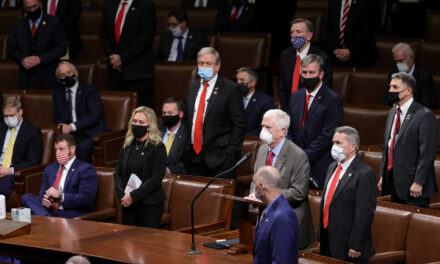
President Biden News: Live Updates

President Biden is set to call into a meeting of Senate Democrats on Tuesday as he pushes for passage of his $1.9 trillion coronavirus relief plan, the first major legislative undertaking of his presidency and one that will pose a high-stakes test of Democratic unity in the 50-50 Senate.
After the House approved the stimulus bill with no support from Republicans over the weekend, Senator Chuck Schumer of New York, the majority leader, is planning for the Senate to take up the measure this week.
As Mr. Biden and Mr. Schumer press ahead, they are facing constraints both in terms of time and vote-counting math. Unemployment benefits scheduled to begin lapsing on March 14, and the president and lawmakers from his party are determined to move quickly.
At the same time, Mr. Biden and Mr. Schumer have exceedingly little room to maneuver in the closely divided Senate, where they cannot afford a single Democratic defection if Republicans are united in opposition to the bill.
On Monday, Mr. Biden met virtually with eight Democratic senators and an independent who caucuses with them, Angus King of Maine. The group, according to a statement from the White House, “was united in the goal of quickly passing a significant package that reflects the scope of the challenges our country is facing.”
On Tuesday, Mr. Biden will again spend time with Democratic senators, this time by calling into their lunch.
One likely topic of discussion: Last-minute tweaks to the bill that centrist senators have been pushing party leaders to adopt. The bill is already on course to change from what the House passed, including striking an increase in the federal minimum wage to $15 an hour, which the Senate parliamentarian has ruled does not meet the requirements of the budget reconciliation process that Democrats are employing to allow the measure to pass with a simple majority.
Other potential changes include efforts to extend benefits for the unemployed by an additional month, compared with the House bill, and possible changes to the money the bill would send to state, local and tribal governments in order to make up for lost tax revenues amid the pandemic recession.

For decades, the same ritual took place after Republican electoral defeats.
Moderate, establishment-aligned party officials would argue that candidates had veered too far right on issues like immigration and would counsel a return to the political center. And conservatives would contend that Republicans had abandoned the true faith and must return to first principles to distinguish themselves from Democrats and claim victory.
In the aftermath of 2020, that debate is scarcely taking place. Republicans have entered a sort of post-policy moment in which the most animating forces in the party are emotions, not issues.
Last weekend, at the Conservative Political Action Conference, there was vanishingly little discussion of why Republicans lost the presidency, the House and the Senate over the last four years, nor much debate about what agenda they should pursue to rebuild the party.
The absence of soul-searching owes in part to the denialism of many activists that they lost the White House at all, a false claim perpetuated with trollish gusto by former President Donald J. Trump himself on Sunday.
Beyond the former president, no two Republicans in attendance drew a more fervent response than Gov. Ron DeSantis of Florida and Gov. Kristi Noem of South Dakota.
Neither sketched out a new policy agenda or presented a fresh vision for a party that has won the national popular vote just once in over 30 years. Rather, they drew repeated ovations for what they share in common: a shared sense of victimhood over media criticism for their handling of the coronavirus crisis and a pugnacious contempt for public health experts who have urged more aggressive restrictions in their states.
“I don’t know if you agree with me, but Dr. Fauci is wrong a lot,” Ms. Noem said in her remarks, referring to the country’s top infectious disease expert. The statement brought attendees to their feet, even as she glossed over her state’s high mortality rate during the pandemic.
Interviews with conference attendees suggested that many of them were drawn to the two governors primarily for their style.
Sany Dash, who was selling merchandise at a CPAC booth, explained that she liked Ms. Noem “because she fights back,” adding: “I feel like she’s a female Trump, except not crass or rude.”
“He’s got just the right amount of Trumpiness to him,” Brad Franklin, a recent college graduate, said of Mr. DeSantis.
Elaina Plott contributed reporting.

As a candidate, President Biden promised to pass a multitrillion-dollar infrastructure package intended to create jobs and help the United States compete with China. And if anything, his first month in office, in which a power crisis in Texas left millions of people in need of water and electricity, has underscored the urgency of upgrading the nation’s aging structural underpinnings.
But while the goal of addressing the United States’ infrastructure is bipartisan, the details are not. That includes how much to spend, what programs count as “infrastructure” and, most important, whether to raise taxes to pay for it.
Economists agree that government investments in infrastructure can help the economy run more efficiently, leading to stronger growth and faster wage gains for workers. That consensus has brought calls from a wide range of groups for lawmakers to pass a major infrastructure bill.
The American Society of Civil Engineers has given the country’s overall infrastructure a grade of D+, estimating that a funding gap of more than $2 trillion exists between needs and expected spending by all levels of government over the next decade. And the pandemic has put a spotlight on the poor quality of digital infrastructure in many parts of the United States, as more people are forced to work and attend school remotely.
“We’ve come to a point as a country where it’s very clear these needs can’t keep being deferred,” Pete Buttigieg, the transportation secretary, said in an interview. “This crisis reflects that.”
Business groups and many Republicans have expressed a willingness to work with the administration to pass $1 trillion or more in infrastructure spending. Areas of agreement with progressives include spending on highways, bridges, rural broadband networks, water and sewer lines and even some cornerstones of fighting climate change, like electric-car charging stations.
But Republicans and business groups have made clear to the administration that some of Mr. Biden’s preferred policies — taxes, in particular — could scuttle any chance of a consensus deal.
“I’m optimistic and hopeful that there will be a meaningful bipartisan agreement here because the needs are clear,” said Aric Newhouse, the senior vice president for policy and government relations at the National Association of Manufacturers.
If Mr. Biden tries to pay for the plan by raising taxes on corporations and other businesses, Mr. Newhouse said, “that would obviously be a huge problem, and make this, instead of a bipartisan effort, a partisan effort.”
Emily Cochrane contributed reporting.
















